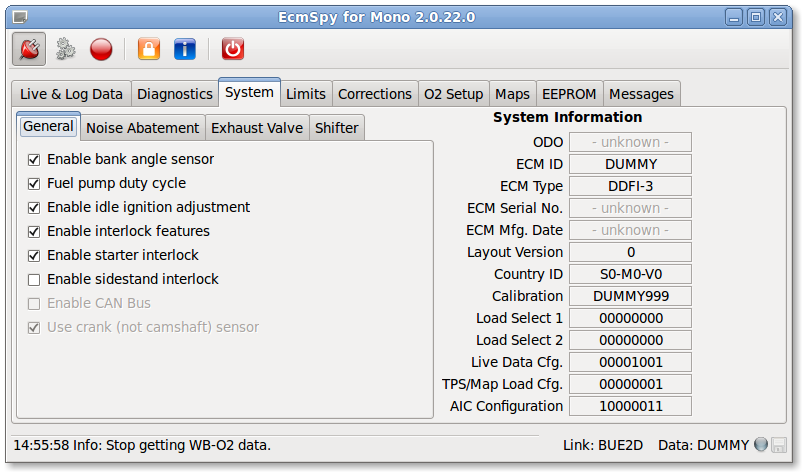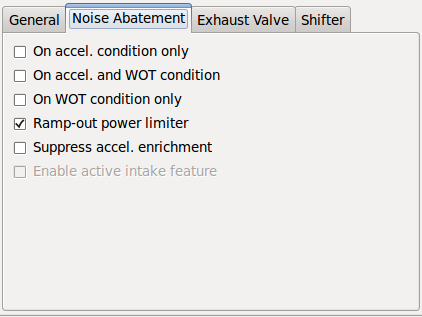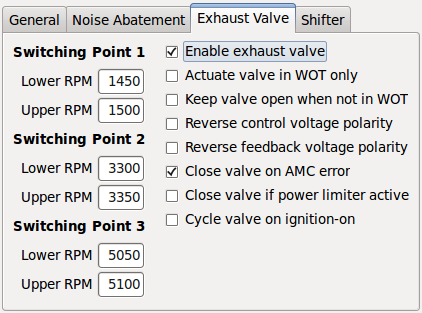"System"
The "System" page is divided into two panes. The left one shows configurable system settings,
and the other one some system informations (readonly).
Top of Page
"System Information"
The system information area shows some detailed data describing the ECM. Not all data are available for every ECM type.

Click image for an unscaled view
"System Settings"
The system settings are devided into several tabs, covering general,
noise abatement, exhaust valve and shifter settings.
Each tab offers a number of checkboxes, that can be marked (switched on) or unmarked (switched off)
to enable or disable a specific feature or setup. Some tabs also contain entries for numerical input.
The various settings are explained in the following lists:
Top of Page

|
-
General Settings:
-
- Bank Angle Sensor
- Activate the bank angle sensor (BAS).
- Fuel pump duty cycle
- Adjust fuel pump duty cycle according to the lookup table.
- Enable idle ignition adjustment
- Automatically adjust idle spark addvance in regard to engine temperature.
- Enable interlock features
- Activate the interlock features (DDFI-3 only).
- Enable starter interlock
- Activate the starter interlock feature (DDFI-3 only).
"Interlock Features" has to be activated also.
- Enable sidestand interlock
- Activate the sidestand interlock feature (DDFI-3 only).
"Interlock Features" has to be activated also.
- Enabble CAN bus
- Activate CAN bus communications (DDFI-3 only, not adjustable).
- Use crank (not camshaft) sensor
- Activate the crank (flywheel) sensor for retrieving a RPM signal (DDFI-3 only, not adjustable).
|
Top of Page

|
-
Noise Abatement Settings
-
- On acceleration condition only
- Activate noise abatement during acceleration only.
- On acceleration And WOT condition
- Activate noise abatement during WOT and acceleration.
- On WOT condition only
- Activate noise abatement while in WOT only.
- Ramp-out power limiter
- Ramp out noise abatement, instead of switching it off.
- Suppress acceleration enrichment
- Do not allow fuel acceleration enrichment while noise abatement is in action.
- Enable active intake feature
- Activate the active intake feature (DDFI-3 only).
|
Top of Page

|
-
Exhaust Valve Settings
-
- Enable exhaust valve
- Activate the exhaust valve feature.
- Actuate valve in WOT only
- Exhaust valve is opened onley when a WOT condition occurs
- Keep valve open when not in WOT
- Keep the exhaust valve open, even if no more in WOT, until RPM threshold is reached.
- Reverse control voltage polarity
- The control voltage polarity for the exhaust valve controller will be reversed.
- Reverse feedback voltage polarity
- Evaluate reversed feedback voltage polarity from the exhaust valve controller.
- Close valve on AMC error
- Close valve when the ECM signals an error condition for the exhaust valve controller.
- Close valve if power limiter active
- Close valve when noise abatement is active.
- Cycle valve on ignition on
- Cycle the exhaust valve once, when ignition is switched on.
|
On the left half of this tab the RPM switching points are listed in ascending order.
The actuator is triggered by passing a RPM switchpoint, but the action can be suspended
if a load condition has been set and is not fulfilled. In that case the valve position won't change.
If the control voltage polarity is reversed, the switching point results are reversed too,
instead of opening the valve it will now be closed. This allows two different control pattern.
With the control voltage reversed, which is the default setup, the exhaust valve opens at the first switching
point, closes at the second one and will be opened at the third RPM threshold.
Top of Page

|
-
Shifter Settings:
-
- Enable shifter feature
- Enable the shifter feature. Please consult the service manual for possible input pins.
This feature also requires some further changes to the EEPROM data to work as desired.
- Shifter transition required
- The shifter switch is required to come back in his previous position to trigger a new event.
- Cut fuel & spark
- Cut fuel and spark when the shift is activated.
|
On the left half of this tab a list of the shifter interrupt durations (in milliseconds) for each gear are shown.





